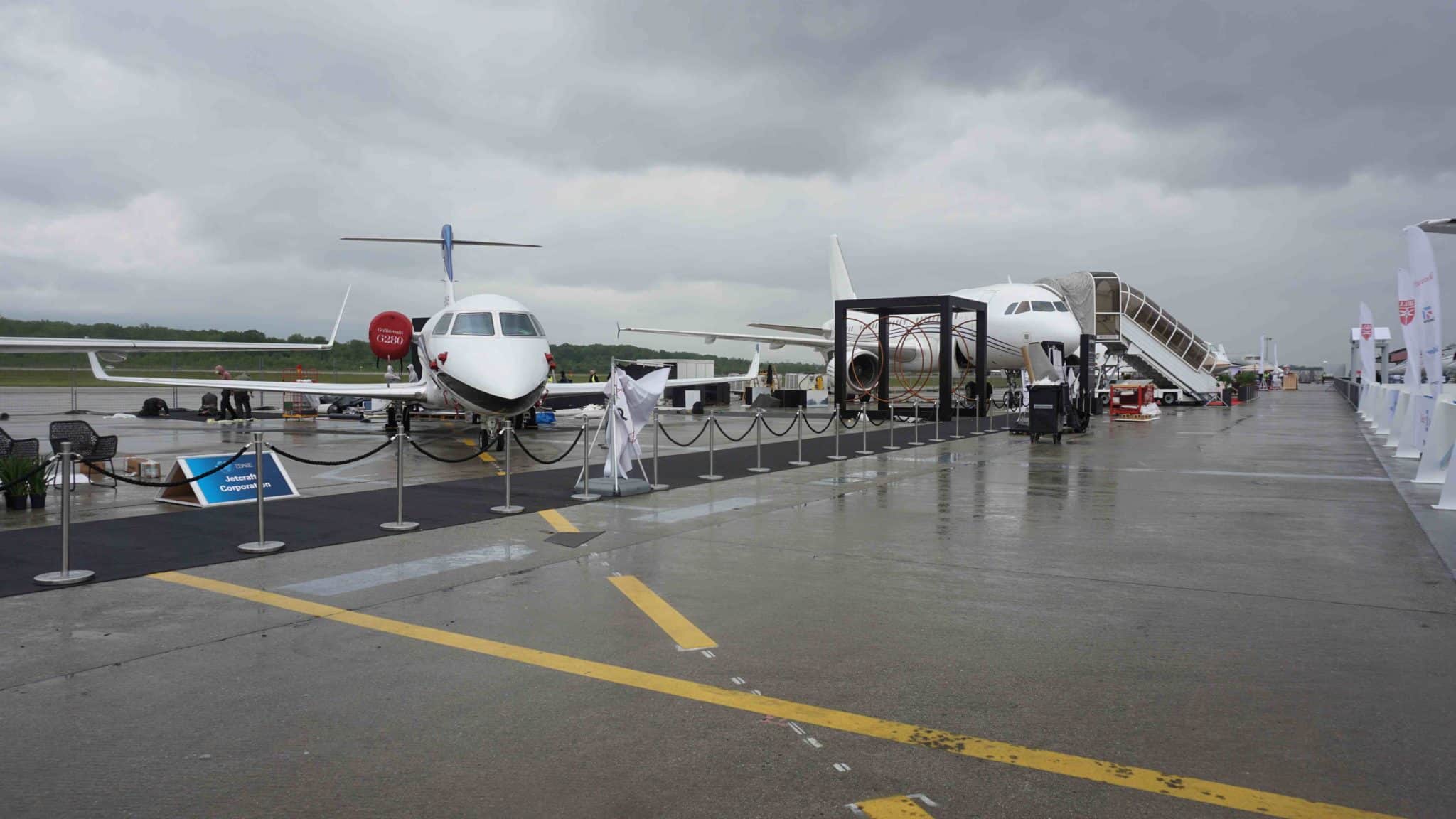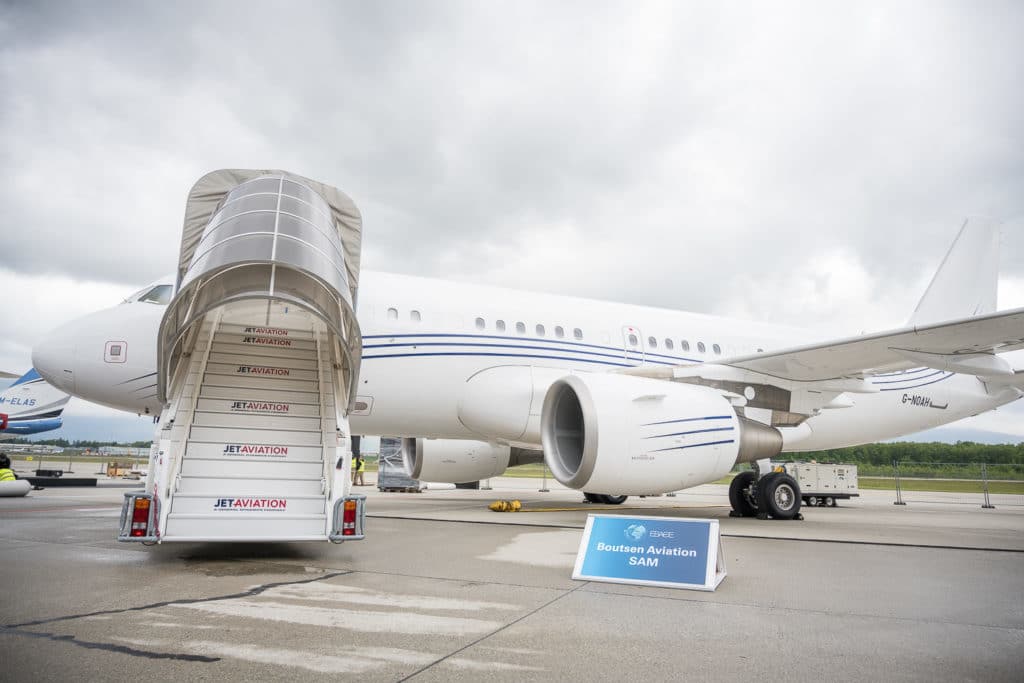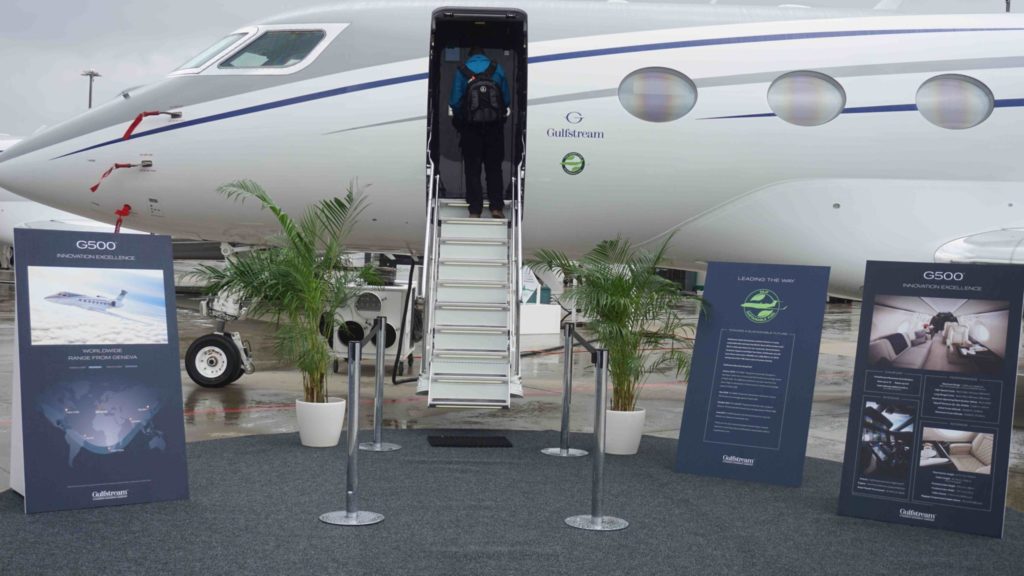Aerospace
ACJ319, Dassault Aviation, Gulfstream is shown at EBACE -2019 Geneva

ACJ319 is shown at EBACE
Airbus Corporate Jets (ACJ) is showing an ACJ319 at EBACE[1], giving potential customers the opportunity to see for themselves how they can fly in greather comfort and space than in traditional business jets.
The aircraft, which is being shown for the first time at EBACE, is operated by K5 Aviation and is available for VVIP charter. It is certificated for 19 passengers.
“Seeing for yourself what a great travel experience you can have in an Airbus corporate jet really highlights the greater comfort and space on offer, which you can have at a competitive price,” says ACJ President Benoit Defforge.
ACJ is growing its ACJ320 Family with new models, which feature new engines and wingtip-mounted Sharklets to deliver a 15 per cent fuel-saving, enabling nonstop travel to even more of the world in the best cabin in the sky.
The new family comprises an ACJ319neo[2] that can fly eight passengers 15 hours or 6,750 nm/12,500 km, and an ACJ320neo that can transport 25 passengers 13 hours or 6,000 nm/11,100 km.
Deliveries of the new models, which have already won 14 orders and commitments, began earlier this year. Airbus has won around 15,000 firm orders for the whole A320 Family, and over 750 A320neo Family aircraft are already in service with airlines.
[URIS id=8789]
GULFSTREAM DISPLAYS SUPPORT FOR SUSTAINABILITY HEADING INTO EBACE
Gulfstream G650ER, Gulfstream G600, Gulfstream G550 And Gulfstream G280 Fly To Geneva Using Sustainable Alternative Jet Fuel
SAVANNAH, Georgia, May 20, 2019 — Gulfstream Aerospace Corp. today announced the
Gulfstream G650ERTM, Gulfstream G600TM, Gulfstream G550TM and Gulfstream G280TM flew to
Geneva for the European Business Aviation Convention & Exhibition using sustainable
alternative jet fuel (SAJF).
“We made SAJF available to our customers earlier this year and are taking as many
opportunities as we can to raise the profile of this sustainable resource,” said Mark Burns,
president, Gulfstream. “Gulfstream led the industry four years ago when we committed to our
own supply of SAJF, and we have been strong supporters of our industry’s efforts to enhance
awareness of the fuel and decrease emissions.”
While flying on SAJF, the G280 set a new city-pair record from Farmingdale, New York, to
Geneva, making the 3,425-nautical-mile/6,343-kilometer flight in 7 hours and 6 minutes at an
average speed of Mach 0.81. Gulfstream made its first sale of SAJF to a Gulfstream operator earlier this year and maintains a customer-dedicated supply of the fuel at its Long Beach, California, facility.
Dassault Aviation at the EBACE 2019 event
The Dassault Aviation group is delighted to be presenting its dual civil and defense know-how at the 2019 edition of EBACE, Europe’s primary business aviation event, to be held in Geneva from 21 to 23 May.
Three Dassault aircraft will be presented in the static display:
- a Falcon 8X tri-jet,
- a Falcon 900LX tri-jet,
- a Falcon 2000S twin-jet.
On its stand, Dassault Aviation will also be presenting:
- a full-scale mock-up of the cabin of the Falcon 6X, the new Falcon twin-jet currently under development. Visitors will be able to enter this mock-up, which is fully representative of the features and comfort of the actual cabin;
- a mock-up of the Rafale, the multi-role combat aircraft, which has proven itself in numerous theatres of operations. The Rafale is a candidate for the Swiss Air Force’s combat fleet renewal program;
- a mock-up of the nEUROn stealth combat UAV demonstrator built under the project leadership of Dassault Aviation, in cooperation with companies from five European countries, including Ruag of Switzerland;
- a representation of the new capabilities of Dassault Aviation’s Falcon maintenance networks, notably following the acquisition of MRO activities of TAG Aviation in Europe and ExecuJet in Asia, Australia, New Zealand, Africa, the Middle East and Europe.

Aerospace
Which is bigger 777x or 787 aircraft ?

The 777X is a new series of the Boeing 777 family and is designed to be larger and more efficient than its predecessor. It features two variants: the 777-8 and the 777-9, being the larger of the two.
The Boeing 777X emerges as the larger sibling within the Boeing family, representing a significant leap forward in both size and efficiency. Comprising two variants, the 777-8 and the 777-9, the latter takes the crown as the larger of the two. With its expansive fuselage and impressive wingspan, the 777X is tailored for long-range journeys and boasts a substantial passenger capacity.
On the other hand, the Boeing 787, affectionately known as the Dreamliner, occupies a niche in the market as a smaller yet formidable aircraft designed for medium to long-range flights. Its distinguishing feature lies in its composite fuselage, a technological marvel that renders it lighter and more fuel-efficient compared to conventional aluminum counterparts. The Boeing 777X is larger than the Boeing 787 aircraft.
When it comes to passenger capacity, the 777-9 reigns supreme, typically accommodating a sizeable contingent of 400-425 passengers in its standard configuration. In contrast, the 787, with its more modest dimensions, typically carries between 240-290 passengers, depending on the variant and layout.
One of the remarkable innovations introduced with the 777X is its folding wingtips, a feature designed to address the logistical challenges of accommodating such a large aircraft in conventional airport gates. These folding wingtips enable the 777X to retract its wings, allowing it to fit into gates designed for smaller aircraft while still reaping the benefits of an extended wingspan during flight, thereby enhancing fuel efficiency and operational flexibility
Aerospace
China Secures Production Certificate for Mass Production of Pilotless eVTOL Aircraft

The first passenger-carrying pilotless electric vertical takeoff and landing (eVTOL) aircraft in the world, the EH216-S, has received the Production Certificate for its eVTOL aircraft from the Civil Aviation Administration of China (CAAC).
This is a significant milestone for EHang Holdings Limited, the leading UAM technology platform company in the world. This outstanding accomplishment is another big step towards mass manufacturing for the eVTOL aircraft and the ensuing commercial operations, building on the ground-breaking acquisition of the Type Certificate and the Standard Airworthiness Certificate for the EH216-S.
The PC is a crucial certificate that the aircraft maker receives from the CAAC, the country’s aviation authority. By obtaining this certificate, EHang has demonstrated that it has set up a quality management system for mass production that satisfies the airworthiness regulation standards set forth by the CAAC, and the company has been given permission to continue producing mass quantities.
It is also a strong guarantee of the calibre of the goods made by EHang. Raw materials, supplier management, manufacturing organisation, production quality control, aircraft pre-delivery test, after-sales repair and maintenance, etc. are all included in the mass production quality management system for the EH216-S.
To ensure that every aircraft and its components that roll off the production line strictly adhere to the approved type design and safety requirements, the system sets clear guidelines and documentation for every step in the production procedure. This ensures comprehensive traceability and safety control.
Aerospace
Four Airbus A380 Superjumbos lined up to be scrapped

In a strategic move aimed at reclaiming valuable resources from the iconic Airbus A380 aircraft, VAS Aero Services and Dr. Peters Group have announced a significant collaboration.
This partnership marks a milestone in aviation logistics and aftermarket services, with four of these colossal planes slated for teardown and redistribution of used serviceable material (USM).
The venture between VAS Aero Services, renowned for its expertise in aircraft dismantlement, and Dr. Peters Group, a prominent Germany-based investment fund management firm, underscores a commitment to sustainable aviation practices. This isn’t their first foray into scrapping A380s; their successful partnership has already seen the dismantlement of these aircraft, making them pioneers in this niche.
Under the agreement, the latest consignment brings the tally to eight A380s entrusted to VAS by Dr. Peters Group. Managing Director Christian Mailly of Dr. Peters Group emphasized the trust placed in VAS, citing their unparalleled capabilities in dismantlement and aftermarket sales network. It’s a strategic move in response to the growing demand for quality USM parts, particularly with the resurgence in reliance on the A380.
Notably, the teardown process will be carried out at various locations, optimizing the positioning of harvested parts to cater to different markets. While some parts will be positioned in Europe to support operators in the region and the Middle East, others will remain in the Asia-Pacific region. This meticulous strategy ensures efficient access to spare parts, benefiting MROs and airlines across these markets.
The decision to retire these A380s comes at a time when operators are reassessing fleet strategies amidst evolving market dynamics. Despite initial plans for quick retirement due to the emergence of more fuel-efficient alternatives, factors such as a rebound in long-haul demand and delays in new widebody deliveries have prompted operators to reconsider. The A380, with its unique capacity and capabilities, presents a practical solution for short-term capacity management.
























